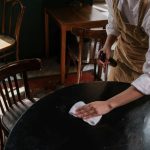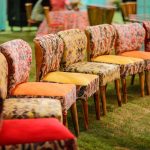If you spot mildew on your fabric lawn chairs, start by brushing off loose dirt and debris. Mix equal parts white vinegar and water in a spray bottle, then spray the affected areas thoroughly. Let it sit for 15 minutes before gently scrubbing with a soft brush. Rinse well with clean water and allow chairs to dry completely. For tougher spots, a baking soda paste helps. Keep them fresh and mildew-free by storing and cleaning properly—there’s more to know about maintaining their look and longevity.
Table of Contents
Key Takeaways
- Identify mildew by looking for small white, gray, or greenish spots with a musty smell and fuzzy texture on fabric lawn chairs.
- Prepare chairs by removing loose dirt and debris with a soft brush and ensure the fabric is dry before cleaning.
- Mix equal parts white vinegar and water in a spray bottle, apply to mildew spots, and let sit for 15 minutes to break down spores.
- Gently scrub treated areas with a soft brush or sponge, then rinse thoroughly with clean water to remove vinegar residue.
- Prevent mildew by storing chairs in dry, ventilated areas, using breathable covers, and regularly cleaning and airing out the fabric.
Identifying Mildew on Fabric Lawn Chairs
Mildew often appears as small, patchy spots that are white, gray, or greenish on your fabric lawn chairs. You’ll usually find these spots in shaded, damp areas where moisture lingers.
Look for small, patchy white, gray, or greenish spots on fabric chairs in damp, shaded areas.
If you notice a musty smell or discoloration on the fabric, that’s another sign mildew has started to develop. Don’t confuse mildew with dirt or stains; mildew tends to have a fuzzy or powdery texture.
You might also spot mildew in seams, folds, or under cushions where air circulation is limited. Catching mildew early is important because it can weaken the fabric and spread quickly.
Once you identify these signs, you can take action to clean and protect your fabric chairs before the mildew causes lasting damage.
Necessary Cleaning Supplies for Mildew Removal
To effectively remove mildew from your fabric lawn chairs, you’ll need a few essential cleaning supplies on hand.
Gather white vinegar or a mild detergent, as these work well to break down mildew without damaging fabric. Have a soft-bristle brush or a sponge ready for gentle scrubbing.
You’ll also need a spray bottle to apply your cleaning solution evenly. Don’t forget rubber gloves to protect your hands from irritation and a bucket for mixing solutions or rinsing.
A hose or access to water will help rinse away residue thoroughly. Finally, keep some clean, dry towels nearby to blot excess moisture after cleaning.
Having these supplies ready guarantees you can tackle mildew efficiently and restore your fabric lawn chairs to a fresh, clean state.
Preparing the Fabric Lawn Chairs for Cleaning
Before diving into the cleaning process, you should thoroughly inspect your fabric lawn chairs for any loose dirt or debris. This step prevents dirt from embedding deeper during washing.
Thoroughly inspect fabric lawn chairs for loose dirt to avoid embedding debris during cleaning.
Begin by:
- Using a soft brush or broom to sweep off leaves, dust, and surface dirt.
- Checking seams and crevices for trapped debris, removing it with a handheld vacuum or a soft cloth.
- Ensuring the chairs are dry before proceeding, as damp fabric can complicate mildew removal.
Using a Vinegar Solution to Treat Mildew
Although stubborn stains can be frustrating, you’ll find that a vinegar solution offers an effective and natural way to tackle mildew on your fabric lawn chairs.
Mix equal parts white vinegar and water in a spray bottle for easy application. Spray the affected areas thoroughly, ensuring the solution soaks into the fabric. Let it sit for about 15 minutes to break down the mildew spores.
Afterward, use a soft brush or cloth to gently scrub the fabric, loosening any remaining mildew. Once done, rinse the chairs with clean water to remove vinegar residue.
Finally, allow the chairs to air dry completely in a sunny spot, as sunlight helps prevent mildew from returning. This method is safe, affordable, and avoids harsh chemicals.
Applying a Baking Soda Paste for Stubborn Mildew
When mildew proves too stubborn for vinegar alone, you can apply a baking soda paste to lift the spores from your fabric lawn chairs.
Start by mixing baking soda with a small amount of water until you get a thick paste. Then:
- Spread the paste generously over the affected areas, covering the mildew spots completely.
- Let the paste sit for at least 15 minutes to allow the baking soda to break down the mildew.
- Use a soft brush or cloth to gently scrub the fabric, lifting the mildew without damaging the material.
After scrubbing, rinse the area thoroughly with clean water to remove all residue.
This method not only removes mildew but also neutralizes odors, leaving your lawn chairs fresh.
Machine Washing and Drying Fabric Lawn Chair Covers
Since fabric lawn chair covers often accumulate dirt and mildew deep within the fibers, machine washing offers an effective way to clean them thoroughly.
First, check the care label to verify your covers are machine washable. Remove any loose debris before placing them in the washer.
Always check the care label and remove loose dirt before machine washing your chair covers.
Use a gentle cycle with cold water and a mild detergent to prevent fabric damage. Adding a cup of white vinegar can boost mildew removal.
Avoid bleach unless the label specifically allows it, as it can weaken the fabric.
After washing, air dry the covers in direct sunlight if possible, since sunlight naturally inhibits mildew growth.
If you must use a dryer, choose a low heat setting to avoid shrinking or warping.
Proper washing and drying will keep your covers fresh and mildew-free.
Preventative Measures to Avoid Mildew Growth
To keep mildew from taking hold, you need to store your fabric lawn chairs properly, preferably in a dry, well-ventilated area.
Regularly cleaning the fabric helps remove moisture and dirt that mildew loves to feed on.
Taking these simple steps will save you time and effort down the road.
Proper Chair Storage
Although mildew often appears after chairs have been left outside for extended periods, proper storage can prevent its growth altogether.
To keep your fabric lawn chairs mildew-free, follow these storage tips:
- Choose a dry, well-ventilated area: Avoid damp basements or sheds where moisture lingers. A garage or covered porch with airflow works best.
- Use breathable covers: Instead of plastic, opt for fabric covers that allow moisture to escape, preventing condensation buildup.
- Store chairs off the ground: Place them on shelves or pallets to avoid contact with damp surfaces and improve air circulation.
Regular Fabric Cleaning
When you clean your fabric lawn chairs regularly, you reduce the chances of mildew taking hold. Dirt, sweat, and moisture can build up on the fabric, creating the perfect environment for mildew to grow.
Make it a habit to brush off loose debris and wipe down the fabric with a mild soap solution every couple of weeks. After cleaning, always let the chairs dry completely in the sun to discourage mildew spores.
If your chairs get wet from rain or spills, dry them as soon as possible. Regular cleaning not only prevents mildew but also keeps your chairs looking fresh and extends their lifespan.
Don’t wait for visible mildew to appear—consistent care is your best defense against stubborn stains and odors.
Tips for Maintaining Clean and Fresh Outdoor Furniture
Keeping your outdoor furniture clean and fresh requires regular care and simple habits. You’ll want to tackle dirt and mildew before they set in.
Regular care and simple habits keep your outdoor furniture clean and prevent dirt and mildew buildup.
Here are three practical tips to maintain your fabric lawn chairs:
- Clean Weekly: Wipe down frames and fabric with mild soap and water to prevent grime buildup.
- Store Properly: When not in use, cover or store chairs in a dry place to avoid moisture exposure.
- Use Protective Sprays: Apply mildew-resistant sprays designed for outdoor fabrics to create a barrier against mold and stains.
Frequently Asked Questions
Can Mildew on Fabric Lawn Chairs Cause Health Problems?
Yes, mildew on fabric lawn chairs can cause health problems. You might experience allergies, respiratory issues, or skin irritation if you’re exposed. It’s important you clean mildew promptly to protect your health and comfort.
Is It Safe to Use Bleach on Fabric Lawn Chairs?
You can use bleach on fabric lawn chairs, but you shouldn’t overdo it. Always dilute it properly and test a small area first to avoid damage or discoloration. Wear gloves and work in a well-ventilated space.
How Long Does Mildew Take to Develop on Outdoor Furniture?
Mildew can start developing on outdoor furniture within 24 to 48 hours in damp, humid conditions. If you don’t dry or clean your furniture quickly, you’ll notice mildew growth much faster than you might expect.
Can Mildew Return After Cleaning Fabric Lawn Chairs?
Yes, mildew can return after cleaning fabric lawn chairs if moisture and warmth persist. You’ll want to keep them dry, store them properly, and clean regularly to prevent mildew from coming back and damaging your chairs.
Are There Commercial Mildew Removers Recommended for Fabric Lawn Chairs?
You might think natural remedies always win, but commercial mildew removers like RMR-86 and Concrobium Mold Control are specifically designed for fabric lawn chairs, making them effective and convenient choices to tackle stubborn mildew quickly.
- Is Acetate Fabric Toxic? A Look at the Chemicals and Safety - June 24, 2025
- What Is Acetate Twill Fabric and What Is It Used For? - June 24, 2025
- How Strong Is Acetate Fabric? A Look at Its Durability and Weaknesses - June 24, 2025







